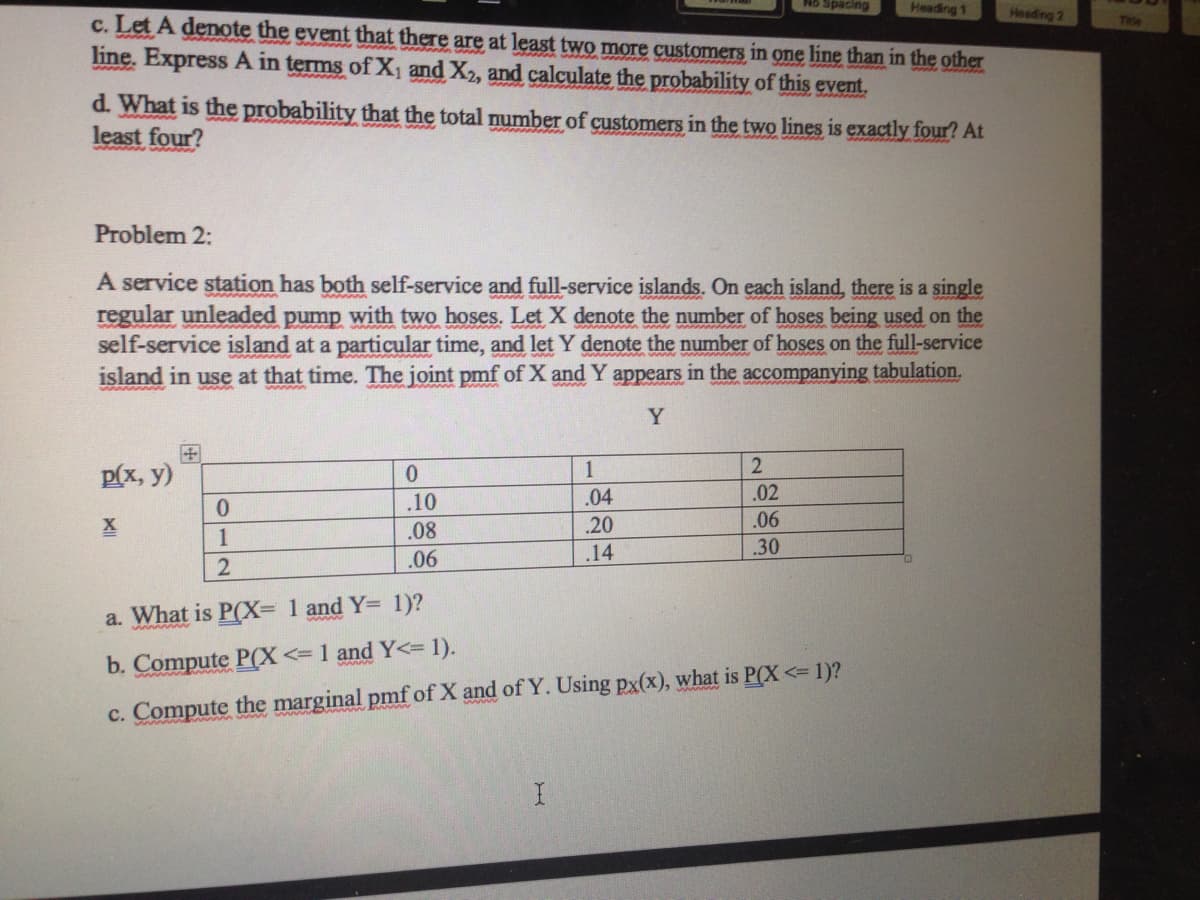a. What is P(X= 1 and Y= 1)? b. Compute P(X<= 1 and Y<= 1). c. Compute the marginal pmf of X and of Y. Using px(x), what is P(X<= 1)?
a. What is P(X= 1 and Y= 1)? b. Compute P(X<= 1 and Y<= 1). c. Compute the marginal pmf of X and of Y. Using px(x), what is P(X<= 1)?
Holt Mcdougal Larson Pre-algebra: Student Edition 2012
1st Edition
ISBN:9780547587776
Author:HOLT MCDOUGAL
Publisher:HOLT MCDOUGAL
Chapter11: Data Analysis And Probability
Section11.8: Probabilities Of Disjoint And Overlapping Events
Problem 2C
Related questions
Question
Quickly please

Transcribed Image Text:Heading 1
Heading 2
c. Let A denote the event that there are at least two more customers in one line than in the other
line. Express A in terms of X1 and X2, and calculate the probability of this event.
Teia
d. What is the probability that the total number of customers in the two lines is exactly four? At
least four?
Problem 2:
A service station has both self-service and full-service islands. On each island, there is a single
regular unleaded pump with two hoses. Let X denote the number of hoses being used on the
self-service island at a particular time, and let Y denote the number of hoses on the full-service
island in use at that time. The joint pmf of X and Y appears in the accompanying tabulation.
Y
1
p(x, y)
.10
.04
.02
.08
.20
.06
1
.14
.30
.06
a. What is P(X= 1 and Y= 1)?
b. Compute P(X<=1 and Y<= 1).
c. Compute the marginal pmf of X and of Y. Using px(x), what is P(X <= 1)?
Expert Solution
This question has been solved!
Explore an expertly crafted, step-by-step solution for a thorough understanding of key concepts.
This is a popular solution!
Trending now
This is a popular solution!
Step by step
Solved in 2 steps

Knowledge Booster
Learn more about
Need a deep-dive on the concept behind this application? Look no further. Learn more about this topic, probability and related others by exploring similar questions and additional content below.Recommended textbooks for you

Holt Mcdougal Larson Pre-algebra: Student Edition…
Algebra
ISBN:
9780547587776
Author:
HOLT MCDOUGAL
Publisher:
HOLT MCDOUGAL

Algebra & Trigonometry with Analytic Geometry
Algebra
ISBN:
9781133382119
Author:
Swokowski
Publisher:
Cengage


Holt Mcdougal Larson Pre-algebra: Student Edition…
Algebra
ISBN:
9780547587776
Author:
HOLT MCDOUGAL
Publisher:
HOLT MCDOUGAL

Algebra & Trigonometry with Analytic Geometry
Algebra
ISBN:
9781133382119
Author:
Swokowski
Publisher:
Cengage
